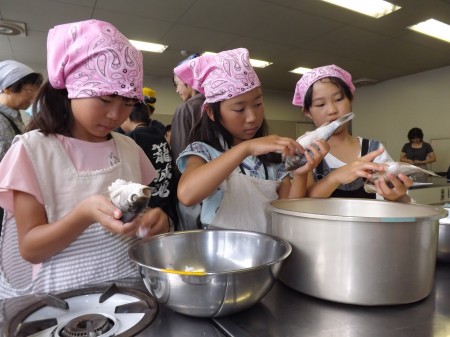eat feel show conserve
Cooking of traditional foods of the Shiga and Lake Biwa area
Eco idea kids, Lake Biwa

Children who participate in this program discover Lake Biwa’s rich bounty by learning how to cook the traditional foods of Shiga Prefecture, as well as coming to love and have pride in their region. This initiative also aspires to the creation of a new food culture through the fostering of relationships.

Being the world’s third oldest lake, Biwa is home to an impressively diverse range of native species. Supported by this rich biodiversity, which includes a number of fish species, a unique food culture has developed around this lake in Shiga Prefecture. By learning how to cook traditional dishes, children taking part in this program also learn about this culture and come to love and have pride for their region’s lush environment. So far, they have learned to make 5 traditional Shiga dishes “Narezushi” (fermented sushi), “Tsukudani” (simmered fish), “Amenoio Gohan” (boiled rice with Biwa trout), “Decchi Yokan” (sweetened red bean paste), and “Hinonazuke” (pickled hinona turnips)] among others.
The children first began by procuring their ingredients. They accompanied fishermen to help catch fish or gather clams from Lake Biwa, and also helped farmers harvest rice and vegetables. They also visited local soy sauce and sake breweries for condiments. Chefs include the elderly, local cuisine researchers, fishermen, and farmers. Each person shared their passion for food and from these experiences the children discovered that traditional dishes are full of ancient wisdom, make excellent use of available ingredients, and are an intricate part of the local culture.
The region’s most famous traditional dish, Funa no Narezushi is a rare type of fermented sushi made with Nigoro-buna (carassius auratus grandoculis or a species of fresh-water ray-finned fish) available in abundance in Lake Biwa. The children also made narezushi with 10 types of lake fish including carp and black bass. The children also learned that the trick to making delicious narezushi is to preserve the fish until winter. To round up the inaugural year, the children invited everyone they met through this program and served their original narezushi creations as a token of their gratitude and to share their new-found appreciation for traditional dishes. This year, the children applied the skills they learned making narezushi to Omi beef, local pork, poultry, deer, and boar meat to create something new using time-tested techniques. To preserve and bequeath Lake Biwa’s unique biodiversity, relationships and biodiversity conservation are key, and these children are learning how they can contribute to these efforts.
更新日:2013.11.03 ※記事の内容は投稿当時のものです









